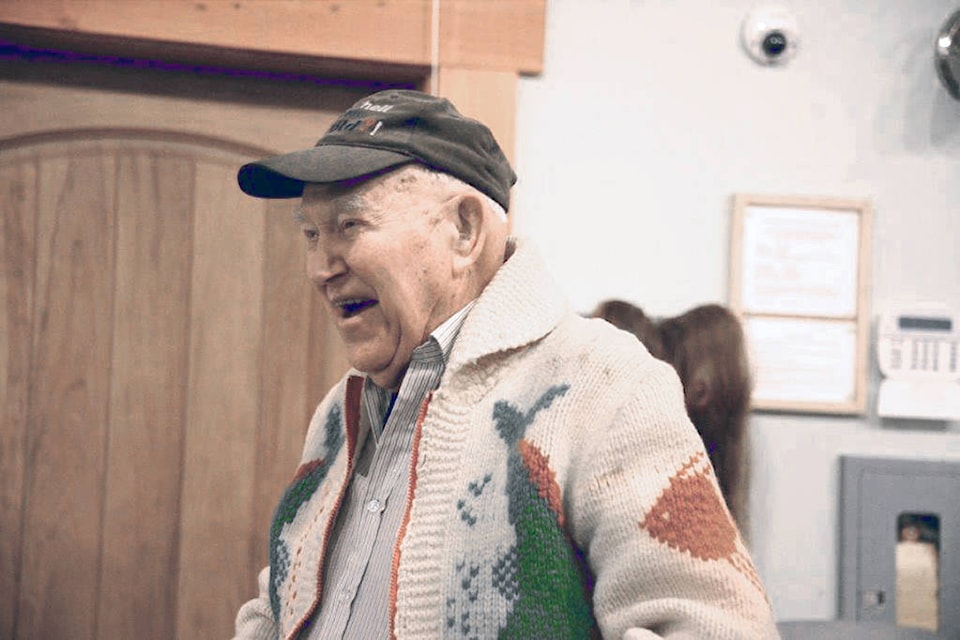Elida Peers | Contributed
Three generations of MacFarlanes have played significant roles in the history of southern Vancouver Island, and Doug was the last, in our neck of the woods.
Doug McFarlane died recently.
It was Doug McFarlane’s grandfather whose enterprising ideas initiated the highway route over the Malahat, way back in the early 20th century.
Doug, born in Victoria in 1927, was the only son of Arthur MacFarlane, a swashbuckling tugboat captain, and his wife Elaine, a lovely gentle lady who had met the swashbuckler when she taught school in the then-remote community of Port Renfrew in 1924.
It was in 1903 that retired Irish army Maj. James MacFarlane owned land in Cobble Hill, and experienced an arduous journey by horse drawn wagon through deep forests to reach Victoria via Sooke Lake and Shawnigan Lake and Goldstream. Alternatives were the E&N Railway or boat.
He explored possible routes for a road, and was repeatedly told it was impossible.
The major continued to harangue government officials, and eventually in 1911, the Malahat Drive, though narrow and primitive in construction, opened and declared a scenic wonderland.
The major’s sons Arthur and Fred both became tugboatmen, and shared ownership of the JWP, a towboat, towing throughout the west coast of Vancouver Island, a busy if hazardous occupation in the height of the glory days of logging and towboating.
It was on the JWP that young Doug cut his teeth, taking part as a crew member at six years old.
I’ve always been amused by the story of Capt. Arthur MacFarlane’s rugged resourcefulness when he steamed into Port Renfrew after an arduous towing job and found the hotel and beer parlour closed and unwilling to serve his crew.
As the hotel stood at the water’s edge, it took but a minute for the six-man crew to reef out the towlines and start encircling the structure. Before they could actually pull the hotel into the water, the innkeeper changed his mind and the beer began to flow.
Doug MacFarlane’s life in Sooke began in 1944 when his parents bought a farm off the Sooke River (once the homestead of Jean Sebastian Brule) on Calvert Road, and the 17-year-old got a job at the fishtraps, based at the foot of Maple Avenue.
In 1949, the MacFarlanes bought extensive holdings from the Sooke River bridge to where Charters Street runs today, as an investment, and turned the acreage alongside the river into a strawberry farm which supplied the Victoria market.
Doug’s parents also built the Bellevue Chalet, a restaurant immediately at the west end of Sooke River bridge, where it became a popular hangout in a town with few eateries.
Doug, meanwhile, had become a dashing young man about town, and was busy squiring the girls around. His best girl was Joan McCauley, daughter of Sooke dentist Dr. W.J. McCauley, and the two spent much time together before Joan’s plans changed and she headed to the U.S.
While Joan married and made her home in Texas, she and Doug remained close friends until her passing just a few years ago.
Doug began his own towboating career with a 32-foot diesel-powered wooden tug built by John Ferneyhough, named the Demac.
In this period, Sooke Forest Products sawmill was extremely busy milling on Goodridge Peninsula, and Doug kept busy towing in log booms from the Strait to the sawmill, and towing out barges carrying wood chips, sawdust and hog fuel, destined for coastal pulp mills.
With a growing workload, Doug, now married to Barbara, arranged for construction of another vessel, the Demac II, a 34-foot diesel-powered tugboat; the account of its launching at Harbour Marine in Victoria was carried by the Victoria Daily Times in January 1966.
Meanwhile, on the homefront, Doug’s three daughters, Debbie, Victoria and Michelle, were growing up on the riverfront farm.
One of the striking features about the home he created for his family was the duo of beautiful magenta-hued rhododendron bushes, surrounded by fields of yellow daffodils.
A seaman who worked for Doug, Mel Hull, commented many years later, “I was privileged to watch a consummate boathandler and seaman at work, and lucky enough to work with a man who taught me to read the tides and the currents and generally conduct myself in boat operations in a fashion that has served me well, in a lifetime at sea.”
As time went on, lives changed, the need for busy towing work in Sooke harbour altered, and Doug retired.
Living a bachelor life, Doug was free to roam about the hills and explore, with friends and the dog he rescued, a golden retriever mix he called Ranger, hiking from the Sooke Hills to the San Juan Valley and throughout the Cowichan Valley as well.
Peter Wilford says: “Time spent with Doug was always a treat for me. He had an incredible memory and an exceptional knowledge of the local area and peoples, which he was always willing to share. To me, he was a kind, humble, generous and incredibly humorous friend.”
For myself, I really appreciated his helpfulness to me and the museum, with his extensive experience and memory of our region’s history, gained over 92 years. He was incredibly generous with his time, and in his kindly nature helped wherever he could.
Much as he loved history, though, his first loves were: his daughters, roaming about the outdoors, and jawing with his buddies. The daughters he leaves behind, Debbie, Victoria and Michelle, plan to host a get-together with friends after spring weather arrives.
•••
Elida Peers is the historian of the Sooke Region Museum.
editor@sookenewsmirror.com
Like us on Facebook and follow us on Twitter
